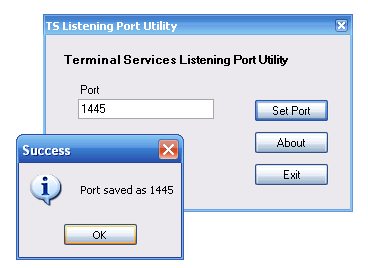
Illustration 1: Terminal Services Listening Port Utility GUI
Introduction
Terminal Services and Remote Desktop both use the RDP protocol and a default port of 3389. Remote Desktop included in Windows XP is a watered down version of Terminal Services, and as such, it only allows for a single user session at a time. In contrast, Terminal Services available in Windows Server 2000 and Windows Server 2003 can be used in two distinctive modes:
- Remote Administration - allowing up to two administrative users to login;
- Application Server Mode - allows n amount of users to process applications on the server.
The Terminal Services Configuration and Management utilities provided by Microsoft as MMC snap-ins do not provide any TCP listening port options. The only way to change a Terminal Server’s default port from 3389 is via the Windows registry.
The Terminal Services Listening Port Utility hopes to showcase a simple managed C++ application which allows convenient modification of a Terminal Servers listening port on supported platforms.
Supported platforms
Background
Having multiple live Terminal Servers at my command, I started to search for means of making them less obvious over the networks. Changing the default Terminal Server port from 3389 to something else seemed like a good place to start. This, in effect, hides a Terminal Server and at least, in theory, should improve security. Sure, Terminal Servers can still be discovered over a network, but only if one was to probe each port physically for a TS response.
Code Outline
The Terminal Services Listening Port Utility retrieves the Terminal Server TCP port value for the default network interface from the registry. The user is presented with the ability to specify a new port value, and if the new value represents a valid port, then the user may store this new value into the Windows registry.
Registry Operations
Registry access is performed via the Microsoft::Win32::RegistryKey class which represents a key level node in the Windows registry. This class is a Registry Encapsulation and is straightforward to use.
private: System::Void MainForm_Load(System::Object * sender,
System::EventArgs * e)
{
txtPortNumber->MaxLength = 5;
regKey = Registry->LocalMachine->
OpenSubKey("System\\CurrentControlSet\\Control"
"\\Terminal Server\\WinStations\\RDP-Tcp",
true );
if(regKey != 0)
txtPortNumber->Text =
regKey->GetValue("PortNumber")->ToString();
else
{
MessageBox::Show("Terminal Server not found in Registry");
btnSet->Enabled = false;
}
}
private: System::Void btnSet_Click(System::Object * sender,
System::EventArgs * e)
{
if(!IsValidPort(txtPortNumber->Text))
errorProvider->SetError(txtPortNumber,
"A Port must be >= 1 and <= 65534");
else
{
errorProvider->SetError(txtPortNumber, "");
if(regKey != 0)
{
regKey->SetValue("PortNumber",
__box(Convert::ToInt32(txtPortNumber->Text)));
MessageBox::Show(String::Format("Port saved as {0}",
txtPortNumber->Text), "Success",
MessageBoxButtons::OK, MessageBoxIcon::Information);
}
}
}
Validation Routines
The Terminal Services Listening Port Utility implements the following two validation algorithms to restrict input and reduce user errors:
private : bool IsValidPort(System::String * txtPort)
{
Int32 iPort = Int32::Parse(txtPort);
if (iPort < 1 || iPort > 65534)
return false;
else
return true;
}
private : bool IsValidInt(System::String * ch)
{
String * format = "0123456789";
if(format->IndexOf(ch)>=0)
return true;
else
return false;
}
private: System::Void txtPortNumber_KeyPress(System::Object * sender,
System::Windows::Forms::KeyPressEventArgs * e)
{
if(!IsValidInt(e->KeyChar.ToString()) )
e->Handled = true;
}
Client Configuration
Don’t forget to configure your Terminal Services client or Remote Desktop client to connect to the new port instead of the default port 3389. Firewalls or other NAT related appliances may have to be reconfigured for either pass through or port forwarding of any new ports.
For example, to instruct the Remote Desktop client utility to connect using the new port, simply append a colon followed by the non-standard port number to the computer address field.

Illustration 2: XP Remote Desktop Client using non standard port
Related Resources
History
- 12/17/04: Original submission
- 12/20/04: Updated resources
